Climate change is no longer a distant threat; it’s a reality that’s impacting our lives today. As homeowners, we have a responsibility to adapt our homes to the changing climate. Fortunately, there are strategic renovations that can help us prepare for the challenges ahead.
In this article, we’ll discuss home remodeling tips for climate change adaptation. We’ll provide valuable insights backed by statistics to guide you in making informed decisions about safeguarding your home against the impacts of a warming world
1. Enhance Insulation and Sealing
One of the most effective ways to adapt your home to climate change is to improve insulation and sealing. According to the U.S. Department of Energy, proper insulation can reduce heating and cooling costs by up to 20%. As climate change leads to more extreme temperatures, a well-insulated home becomes crucial for comfort and energy efficiency.
2. Invest in Energy-Efficient Windows and Doors
Energy-efficient windows and doors not only keep your home comfortable year-round but also reduce energy consumption. The Environmental Protection Agency (EPA) reports that ENERGY STAR-certified windows and doors can save homeowners an average of 12% on their energy bills. This helps mitigate the environmental impact of increased energy use due to climate change.
3. Upgrade Your Roof
Roofing materials play a significant role in protecting your home from climate-related threats like extreme heat and heavy rainfall. Consider cool roofing options that reflect more sunlight and absorb less heat. The Oak Ridge National Laboratory found that cool roofs can lower a home’s cooling costs by 7-15%.
4. Flood-Resistant Landscaping
Climate change brings an increased risk of flooding. Implementing flood-resistant landscaping, such as using permeable pavers and rain gardens, can help manage excess water. According to the National Oceanic and Atmospheric Administration (NOAA), every $1 spent on flood-resistant measures can save $5 in future damages.
5. Install Solar Panels
Harnessing renewable energy sources like solar power not only reduces your carbon footprint but also provides energy security in times of climate-related power disruptions. The Solar Energy Industries Association reports that solar panel installations have grown by over 42% in the last decade.
6. Consider Backup Power Systems
Climate change-related extreme weather events can result in power outages. Investing in a backup power system, such as a generator or a home battery, ensures that you have access to essential electricity during emergencies.
Adapting your home to the challenges of climate change is not only a responsible choice but also a wise investment. These home remodeling tips, backed by statistics and research, empower you to make informed decisions that enhance your home’s resilience, energy efficiency, and overall sustainability. By taking action today, you can protect your home and contribute to a more sustainable and climate-resilient future. Remember, every step you take towards climate change adaptation in your home makes a difference.


